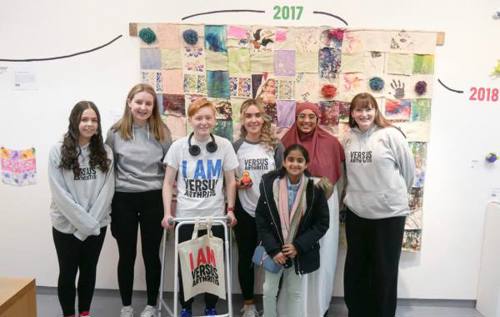Distraction, expression, or a moment of joy: How creativity helps people with arthritis
12 April 2024
As well as getting the right diagnosis and taking the right medicine, there are plenty of small ways you try to manage your pain levels yourself.
You could stay active, protect your joints, and try pacing. But, for many people, there’s another tool that helps them cope with their pain — being creative.
From painting to writing, gardening to music, being creative can give us a much-needed distraction, relief, or even a moment of joy when we’re in pain.
Discover how some people living with arthritis use their creative hobbies to deal with the ups and downs of their condition.
Crafting
 Laura and Steph both live with juvenile idiopathic arthritis (JIA), a type of arthritis that starts before 16 years old.
Laura and Steph both live with juvenile idiopathic arthritis (JIA), a type of arthritis that starts before 16 years old.
This happens when the immune system (which is the body’s natural self-defence system) attacks the body. This causes many symptoms including painful, stiff, and swollen joints.
Laura and Steph are also keen members of Joint Creativity, our art programme in Scotland for 10–18-year-olds living with arthritis.
Like many young people involved in the programme, they’ve rolled up their sleeves and painted, sculpted, and created some show-stopping artwork. Then we showcased their masterpieces in a one-of-a-kind art exhibit in Scotland.
“Having that time to be creative helps you to slow down, forget about your worries and enjoy making something,” Laura says.
“The best thing about crafting for me is that it either makes me forget that I am sore, or I'm enjoying myself so much that I don't mind being sore afterwards!”
Meanwhile, Steph finds that making art is a great way to meet like-minded people and chat about what she’s going through.
“I think making art and having a task to work on together made it a lot easier to talk,” she says. “Being creative at Joint Creativity definitely gave me a break, time to see people, have fun.”
Knitting
Rachel lives with osteoarthritis and a type of joint hypermobility syndrome called Ehler’s Danlos Syndrome. This means you can move your joints more than most people can, which can sometimes lead to pain, fatigue and injuries.
For Rachel, picking up her knitting needles has been a great distraction from her pain.
“When you find yourself not being able to move around a lot, you find yourself doing a lot more other activities – and knitting is one of those things for me,” she explains.
“It massively helps me. It's an easy way to get your brain to do something, without focusing on your pain.”
“You could be thinking or talking, but because your hands are doing something, you don’t focus as much on the pain in your back. It allows me to focus so much more.”
73-year-old Margaret, who lives with cervical spondylosis and osteoarthritis, says that knitting is a great way to unwind.
“It’s therapy for the soul. Knitting is a great hobby. It can be used not only as a tool to keep your hands going, but as a social tool, too."
Reading
There’s nothing like getting lost in an amazing book. But it can also be a great way to distract yourself if you have painful or achy joints.
Lydia, 24, lives with undifferentiated inflammatory arthritis and is a keen member of Young Readers Versus Arthritis. This is our growing book club for young people (aged 11-24) living with arthritis and musculoskeletal conditions.
Lydia says reading has been a “fantastic” way to pass the time when waiting for hospital appointments. But, more importantly, reading books with disabled characters has made her feel “seen.”
After reading a book about a 17-year-old living with juvenile idiopathic arthritis, Lydia says she “kept seeing myself in the character and had to pause to reflect”.
“It was very comforting because it felt like it was written with me as the target audience, which I don't get from books much. It was almost like I knew her. I viewed her as one of my friends from Versus Arthritis.”
Learn more about our book clubWriting
 When you’ve been diagnosed with arthritis, it can stir up a lot of emotions. You might feel shocked, anxious or even a bit overwhelmed – and it can take a bit of time to adapt.
When you’ve been diagnosed with arthritis, it can stir up a lot of emotions. You might feel shocked, anxious or even a bit overwhelmed – and it can take a bit of time to adapt.
For some people, writing can be a great way to sift through their emotions.
Mellisa, 25, lives with lupus and finds journalling is a helpful way to manage her stress levels. Lupus is a long-term condition that can cause inflammation in the skin, organs, and in various other places in the body.
“I do a gratitude journal in the morning where I’ll write down what I'm grateful for, how my day's gone so far, and I’ll reflect on it,” Melissa says. “It's important to write your worries down because sometimes they can build up.”
Gabi, 16, lives with juvenile idiopathic arthritis (JIA) and juvenile dermatomyostis. For her, writing poetry has helped her tap into how she’s feeling.
“I hadn’t realised how much I’d struggled, until I started writing poems,” she says. “It helps you understand that, even though you have the condition, you aren’t alone.”
If you have trouble gripping a pen, you could even try audio journalling. Simply chat through your thoughts or worries using a voice recorder or an app on your device.
Life drawing
Katie, 28, was diagnosed with juvenile rheumatoid arthritis when she was just five years’ old.
Together with a friend, she’s turned her love of drawing and painting into a side business – and it’s gone from strength to strength.
“The life drawing is a little side project... It’s exciting to see where it’s going to go,” she says. “It’s nice to have it as it gives me something else to focus on and is such a nice distraction.
“It’s such a good form of mindfulness and puts me back into a state of calm.”
Music
 Joy, 71, lives with rheumatoid arthritis, osteoarthritis and polymyalgia rheumatica. She says that singing and dancing helps lift her spirits when she’s feeling low.
Joy, 71, lives with rheumatoid arthritis, osteoarthritis and polymyalgia rheumatica. She says that singing and dancing helps lift her spirits when she’s feeling low.
“Music really helps when you’re feeling miserable,” she explains. “When I’m downstairs in the kitchen I’ll put on country music. I enjoy music as a tool to get me through things.
“Even if you think you can’t move and you’re very stiff, put on some music and you can find your hips wiggle a little bit, your shoulders wiggle a little bit.
Meanwhile, William, 10, lives with juvenile idiopathic arthritis and finds that singing relaxes him — so much so, he’s become a senior chorister.
“Singing and music relaxes my pain,” he says. I’m at peace with my pain in the cathedral.”
Learn more about managing your painWe’re here for you
We know it can be tough living with pain and fatigue. If you need more advice or support, remember you can always:
- Call our free helpline on 0800 5200 520
- Chat to our Arthritis Virtual Assistant
- Join our online community
- Stay in touch and follow us on X (Twitter), Facebook and Instagram.